| Blenniidae (Combtooth blennies), subfamily: Salariinae |
| 11.8 cm FL (male/unsexed) |
|
demersal; marine; depth range 0 - 3 m |
| Western Pacific: South China Sea and Gulf of Thailand. |
|
Dorsal spines (total): 13-13; Dorsal soft rays (total): 15-16; Anal spines: 2-2; Anal soft rays: 16-18. Pale olive grey with 3 broad, dusky bands radiating from eye, series of H-shaped dark bars on side of body, and large black spot distally between first and second dorsal spines. Dorsal fin deeply notched; anal rays rarely 16; pectoral rays usually 14; pelvic spine not visible externally; last lateral-line tube below 10th dorsal spine to caudal peduncle; nape with 1 cirrus on each side; supraorbital tentacle blade-like without cirri; anterior nostril cirri present posteriorly; upper lip margin crenulate medially; body depth at anal-fin origin about 5.0 in SL (Ref. 90102). |
| Adults are found on exposed rocky coasts in the intertidal zone to 3 m deep (Ref. 90102). Oviparous. Eggs are demersal and adhesive (Ref. 205), and are attached to the substrate via a filamentous, adhesive pad or pedestal (Ref. 94114). Larvae are planktonic, often found in shallow, coastal waters (Ref. 94114). |
|
Least Concern (LC); Date assessed: 20 March 2012 Ref. (130435)
|
| harmless |
Source and more info: www.fishbase.org. For personal, classroom, and other internal use only. Not for publication.
